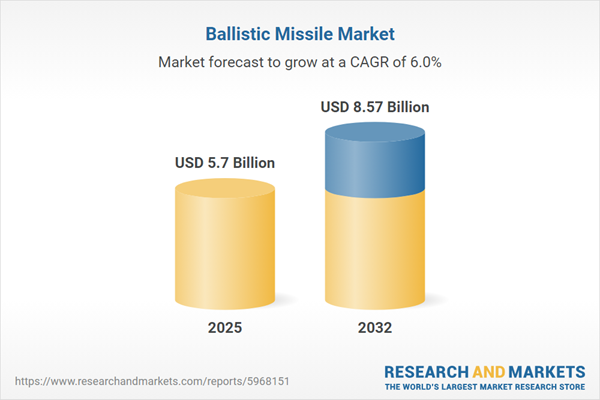Speak directly to the analyst to clarify any post sales queries you may have.
The ballistic missile market is advancing with sustained innovation, increased agility requirements, and a growing emphasis on adaptable defense solutions. Senior leaders must assess these shifting dynamics to ensure strategic alignment and maintain operational effectiveness.
Ballistic Missile Market Snapshot
In 2024, the ballistic missile market reached a value of USD 5.38 billion, with a projected compound annual growth rate (CAGR) of 5.98% through 2032. This stable upward trajectory reflects the ongoing priority placed on defense modernization worldwide. Global military organizations are reevaluating missile system acquisition methods to address increasingly complex operational demands—prompting faster procurement cycles and greater flexibility. Strategic partnerships within the industry are growing in significance as organizations seek sustained readiness amid evolving supplier landscapes, often shaped by regulatory considerations and shifting mission profiles.
Scope & Segmentation of the Ballistic Missile Market
This executive analysis identifies the primary drivers influencing capital decisions, risk management, and procurement trends in the ballistic missile sector. Market segmentation enables deeper understanding of technical adoption, user priorities, deployment frameworks, and regional influences to support strategic planning.
- Range: Encompasses intercontinental, intermediate, medium, and short-range systems developed for mission-specific and varied security environments.
- Propulsion Type: Includes solid, liquid, and hybrid propulsion technologies, each offering distinct operational advantages in reliability, deployment speed, and flexibility.
- Deployment Mode: Covers mobile, silo, and submarine-launched systems, supporting considerations for platform survivability and responsiveness.
- Platform: Assesses land, air, ship, and submarine launch capabilities, facilitating robust multi-domain military integration.
- Warhead Type: Differentiates between conventional and nuclear payloads, directly impacting policy selection and mission execution strategies.
- Guidance System: Considers inertial, satellite-aided, and terminal guidance options, ensuring effectiveness and reliability in diverse engagement scenarios.
- End User: Identifies needs across Air Force, Army, and Navy branches, reflecting evolving modernization and operational frameworks.
- Geographic Coverage: Analyzes regional trends and drivers in the Americas, Europe, Middle East & Africa, and Asia-Pacific, allowing customizable planning for risk and regulatory evolution.
- Companies Profiled: Highlights established industry leaders such as Lockheed Martin, Raytheon Technologies, Northrop Grumman, MBDA SAS, The Boeing Company, BAE Systems, China Aerospace Science and Technology Corporation, Concern PVO Almaz-Antey, Rosoboronexport, and Rafael Advanced Defense Systems for benchmarking best practices and innovation roadmaps.
Understanding these segments supports informed capital allocation, strategic risk management, and the ability to anticipate shifts in defense requirements across different regions and technological domains.
Key Takeaways for Senior Decision-Makers
- Emerging technologies, such as hypersonic propulsion and artificial intelligence, advance operational flexibility, streamline deployment, and expand integration potential across multiple platforms.
- Persistent global security volatility is prompting defense agencies and alliances to strengthen risk oversight and maintain adaptive procurement protocols.
- Modular system design enables streamlined lifecycle management, facilitating rapid upgrades and customization to meet changing mission needs.
- Expanded digital engineering and effective collaboration shorten development timelines, accelerating multinational project integration and capability adoption.
- Regional production focus and adaptive supply chains enhance resilience against shifting geopolitical and regulatory challenges, safeguarding critical supply continuity.
- Implementation of advanced AI decision-support systems and strengthened cybersecurity is essential for protecting command infrastructure from emergent threats in the digital domain.
Tariff Impact and Supply Chain Considerations
Recent U.S. tariffs on ballistic missile components, notably specialized alloys and advanced electronics, are raising production costs and affecting project scheduling. To navigate these dynamics, industry decision-makers are intensifying domestic and regional sourcing strategies to secure supply chain integrity and reduce reliance on unpredictable global trade. Targeted investments in building technical expertise and integrated planning tools are further enhancing sector resilience, minimizing the risk of disruption across defense programs.
Methodology & Data Sources
This ballistic missile market report consolidates expert input, feedback from technical professionals, and thoroughly validated market data. A multi-source approach ensures the reliability and accuracy of insights to support high-level strategy formulation.
Why This Ballistic Missile Market Report Matters
- Delivers clear guidance on evolving market dynamics and compliance trends, supporting informed investment and procurement planning.
- Enhances risk management by enabling responsive strategies for rapidly changing security and regulatory environments.
- Enables organizational benchmarking and continuous improvement, underpinning ambitious innovation and transformation initiatives.
Conclusion
This research equips decision-makers with precise strategic intelligence and actionable guidance. By leveraging these insights, organizations can foster resilience and readiness within the dynamic global defense environment.
Additional Product Information:
- Purchase of this report includes 1 year online access with quarterly updates.
- This report can be updated on request. Please contact our Customer Experience team using the Ask a Question widget on our website.
Table of Contents
3. Executive Summary
4. Market Overview
7. Cumulative Impact of Artificial Intelligence 2025
Companies Mentioned
The companies profiled in this Ballistic Missile market report include:- Lockheed Martin Corporation
- Raytheon Technologies Corporation
- Northrop Grumman Corporation
- MBDA SAS
- The Boeing Company
- BAE Systems plc
- China Aerospace Science and Technology Corporation
- Concern PVO Almaz-Antey (JSC)
- Rosoboronexport (State Company)
- Rafael Advanced Defense Systems Ltd.
Table Information
| Report Attribute | Details |
|---|---|
| No. of Pages | 181 |
| Published | October 2025 |
| Forecast Period | 2025 - 2032 |
| Estimated Market Value ( USD | $ 5.7 Billion |
| Forecasted Market Value ( USD | $ 8.57 Billion |
| Compound Annual Growth Rate | 5.9% |
| Regions Covered | Global |
| No. of Companies Mentioned | 11 |









